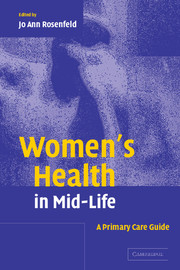Book contents
- Frontmatter
- Contents
- List of contributors
- 1 Introduction
- Part I Health promotion
- 2 Physical activity and exercise
- 3 Nutrition
- 4 Psychosocial health promotion of mid-life women
- 5 Sexual health
- 6 Alcoholism, nicotine dependence, and drug abuse
- 7 Depression and anxiety
- Part II Hormonal changes
- Part III Disease prevention
- Part IV Cancer prevention
- Index
- References
2 - Physical activity and exercise
from Part I - Health promotion
Published online by Cambridge University Press: 21 August 2009
- Frontmatter
- Contents
- List of contributors
- 1 Introduction
- Part I Health promotion
- 2 Physical activity and exercise
- 3 Nutrition
- 4 Psychosocial health promotion of mid-life women
- 5 Sexual health
- 6 Alcoholism, nicotine dependence, and drug abuse
- 7 Depression and anxiety
- Part II Hormonal changes
- Part III Disease prevention
- Part IV Cancer prevention
- Index
- References
Summary
Introduction
For our ancestors, physical activity was ingrained in daily life. In the early 1900s, before automobiles were invented and mass-produced, walking was a common mode of transportation. Today, automobiles are used for leisurely one-mile drives to the local video store or half-mile treks to the grocery store. Improved technology has reduced our physical activity level by making life “easier.”
This “easier” way of life has added to increases in cardiovascular disease, hypertension, high cholesterol, osteoporosis, obesity, and diabetes mellitus. In 1999, cardiovascular disease was the leading cause of death for women in the USA. The American Heart Association states that one in five women has some form of blood vessel or heart disease, 5.7 million women have physician-diagnosed diabetes mellitus, and almost half (46.8%) of non-Hispanic white women are overweight; 23.2% are obese. Genetics cannot be ruled out as a contributing factor to these chronic conditions, but it must also not be an excuse.
In addition to increased morbidity, physical inactivity also has an effect on the economy, amounting to $24 billion of US healthcare expenditures. The yearly cost of medical care for a physically active individual is approximately $330 less than that for an inactive person. Furthermore, if inactive people became active, $76.6 billion in year-2000 dollars would have been saved in direct medical costs. Intuitively, these data would be an alarming incentive for health insurance companies to embrace interventions that focus on the prevention of disease; however, that medical paradigm is not yet emphasized.
Keywords
- Type
- Chapter
- Information
- Women's Health in Mid-LifeA Primary Care Guide, pp. 7 - 22Publisher: Cambridge University PressPrint publication year: 2004



